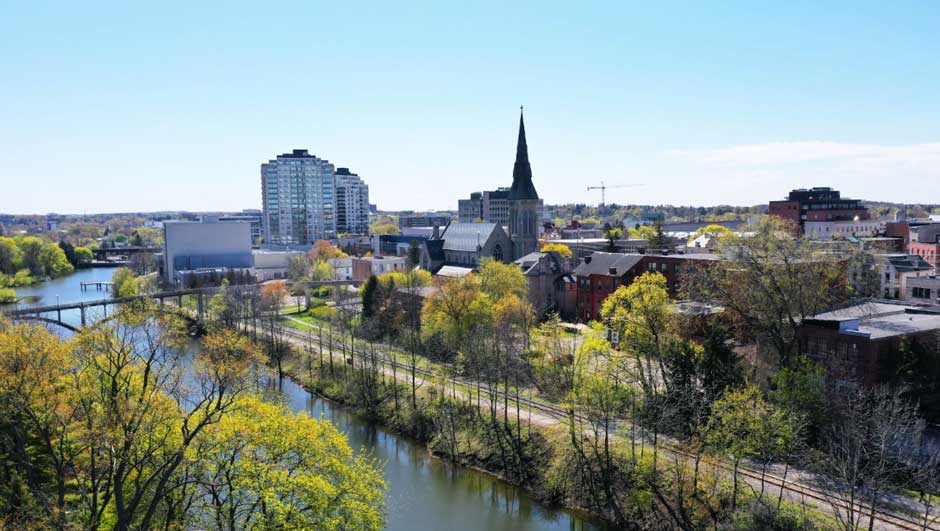At just an hour’s drive from Toronto, Guelph offers an easy getaway in southwest Ontario. It has been nicknamed the “Royal City” as it was named in honour of Britain’s royal family and was officially founded on St. George’s Day in 1827. Guelph is surrounded by picturesque farmlands and glacial-carved landscapes that will appeal to nature lovers while also boasting plenty of cultural attractions within the city itself.
In this guide, we’ll give you the low down on all the top things to see and do in Guelph, as well as the best time to visit this enchanting city. Your accommodation needs are easily sorted at rentola.ca where you’ll find holiday rental properties both within the city limits and in the surrounding countryside. There are options to suit nature lovers ready to hit Guelph’s hiking and skiing trails, as well as history buffs wanting to follow in the literary footsteps of the World War I poet, John McCrae.
Best time to visit Guelph
For the warmest temperatures, coincide your visit to Guelph with the summer months (June through to August) when you should encounter predominantly sunny skies. This is, however, the busiest tourist season in the city, with accommodation prices reflecting the demand. Spring (March through to May) or fall (September through to November) are good alternatives if you want to avoid the crowds. Winter temperatures can drop below freezing, with a handful of snow days expected each month.
Delve into the past at the Guelph Civic Museum
Occupying a mid-19th-century convent, the Guelph Civic Museum showcases the natural and cultural history of the city through both permanent and changing exhibitions. Its roughly 40,000 artefacts include antique furnishings, textiles and toys gifted by local residents, as well as folk and decorative art pieces. If you’re travelling with kids, don’t miss the Guelph Children’s Museum, which boasts interactive and hands-on exhibits.
Visit the Art Gallery of Guelph
Since the 1970s, the Art Gallery of Guelph has hosted not only changing art exhibitions but also cultural activities for the local community. Its gallery spaces showcase a permanent collection that numbers more than 9,000 pieces, as well as touring exhibitions from Canada and beyond. Adjacent to the Art Gallery of Guelph is a sculpture park featuring works by local and international artists. Don’t miss the well-stocked gallery shop for design-themed gifts.
Learn about wartime poetry at McCrae House
Now designated as a National Historic Site of Canada, this humble limestone cottage was once home to the poet behind “In Flanders Fields”. It was written by John McCrae in 1915 and touched on the futility of war, going on to become one of the most famous poems about World War I. At McCrae House, you can learn about his life and legacy, with the cottage decorated as it would have appeared at his time of birth in 1872.
Marvel at the Basilica of Our Lady Immaculate
Dominating the highest point of Guelph is this twin-towered basilica, which was constructed in a Gothic Revival style on the designs of Joseph Connolly. It is renowned for its decorative carvings and exquisite stained-glass windows, as well as a beautiful portal mosaic. While the Basilica of Our Lady Immaculate was established in 1876, its 61-metre-high towers were not completed until 1926. Coincide your visit with a service to experience its vaulted interior or book in for a guided tour.
Get active in the Guelph Lake Conservation Area
Located directly north of the city centre is this popular recreational area, which centres around a reservoir that was created in 1974. In the warm, summer months, you can swim from one of the sandy beaches, go kayaking and sailing, or cast a fishing line to lure bass and pike. More than five kilometres of hiking trails wind their way through the conservation area, with many transforming into snowshoeing and cross-country skiing trails in the winter months.
Visit the Guelph Arboretum
Managed by the University of Guelph, this impressive arboretum encompasses more than 160 hectares on the eastern edge of the city centre. It was created in 1970 with the Harvard University Arboretum as its inspiration and is planted with a diverse collection of native Ontario trees. While the Guelph Arboretum is used for research and education purposes, it’s also a picturesque place to stroll, with meadows, woodlands and wetlands to discover.
Explore the ruins of the Rockwood Conservation Area
Formed over centuries by glaciers, the Rockwood Conservation Area encompasses flowstone caves, kettle potholes and 200-metre-wide bluffs that make it a geological wonderland. It’s also home to the ruins of a historic mill that was founded in 1868 and operated until the Great Depression. You can stretch your legs on the hiking trails that wind through its old-growth forest or cast a fishing line in the Eramosa River to catch rainbow trout.

